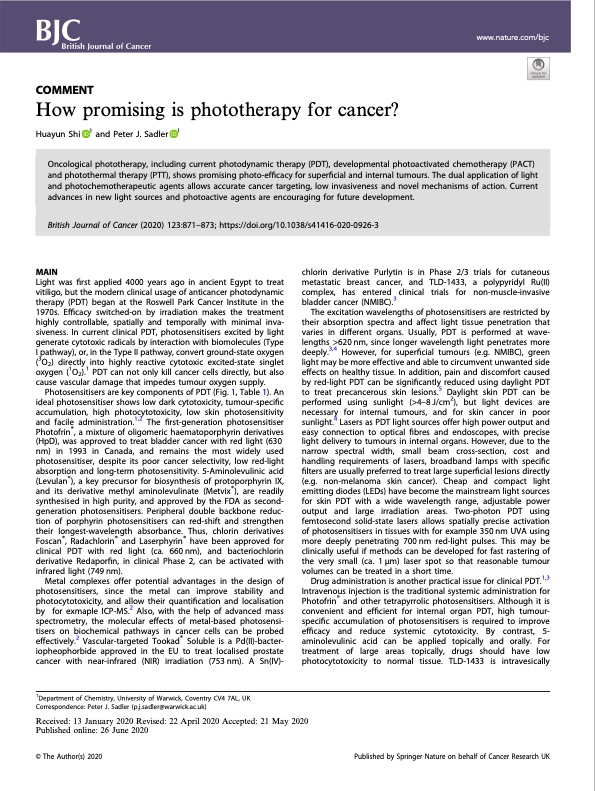
PDF Publication Title:
Text from PDF Page: 001
www.nature.com/bjc COMMENT How promising is phototherapy for cancer? Huayun Shi 1 and Peter J. Sadler 1 Oncological phototherapy, including current photodynamic therapy (PDT), developmental photoactivated chemotherapy (PACT) and photothermal therapy (PTT), shows promising photo-efficacy for superficial and internal tumours. The dual application of light and photochemotherapeutic agents allows accurate cancer targeting, low invasiveness and novel mechanisms of action. Current advances in new light sources and photoactive agents are encouraging for future development. British Journal of Cancer (2020) 123:871–873; https://doi.org/10.1038/s41416-020-0926-3 MAIN Light was first applied 4000 years ago in ancient Egypt to treat vitiligo, but the modern clinical usage of anticancer photodynamic therapy (PDT) began at the Roswell Park Cancer Institute in the 1970s. Efficacy switched-on by irradiation makes the treatment highly controllable, spatially and temporally with minimal inva- siveness. In current clinical PDT, photosensitisers excited by light generate cytotoxic radicals by interaction with biomolecules (Type I pathway), or, in the Type II pathway, convert ground-state oxygen (3O2) directly into highly reactive cytotoxic excited-state singlet oxygen (1O2).1 PDT can not only kill cancer cells directly, but also cause vascular damage that impedes tumour oxygen supply. Photosensitisers are key components of PDT (Fig. 1, Table 1). An ideal photosensitiser shows low dark cytotoxicity, tumour-specific accumulation, high photocytotoxicity, low skin photosensitivity and facile administration.1,2 The first-generation photosensitiser Photofrin®, a mixture of oligomeric haematoporphyrin derivatives (HpD), was approved to treat bladder cancer with red light (630 nm) in 1993 in Canada, and remains the most widely used photosensitiser, despite its poor cancer selectivity, low red-light absorption and long-term photosensitivity. 5-Aminolevulinic acid (Levulan®), a key precursor for biosynthesis of protoporphyrin IX, and its derivative methyl aminolevulinate (Metvix®), are readily synthesised in high purity, and approved by the FDA as second- generation photosensitisers. Peripheral double backbone reduc- tion of porphyrin photosensitisers can red-shift and strengthen their longest-wavelength absorbance. Thus, chlorin derivatives Foscan®, Radachlorin® and Laserphyrin® have been approved for clinical PDT with red light (ca. 660nm), and bacteriochlorin derivative Redaporfin, in clinical Phase 2, can be activated with infrared light (749 nm). Metal complexes offer potential advantages in the design of photosensitisers, since the metal can improve stability and photocytotoxicity, and allow their quantification and localisation by for exmaple ICP-MS.2 Also, with the help of advanced mass spectrometry, the molecular effects of metal-based photosensi- tisers on biochemical pathways in cancer cells can be probed effectively.2 Vascular-targeted Tookad® Soluble is a Pd(II)-bacter- iopheophorbide approved in the EU to treat localised prostate cancer with near-infrared (NIR) irradiation (753nm). A Sn(IV)- 1Department of Chemistry, University of Warwick, Coventry CV4 7AL, UK Correspondence: Peter J. Sadler (p.j.sadler@warwick.ac.uk) chlorin derivative Purlytin is in Phase 2/3 trials for cutaneous metastatic breast cancer, and TLD-1433, a polypyridyl Ru(II) complex, has entered clinical trials for non-muscle-invasive bladder cancer (NMIBC).3 The excitation wavelengths of photosensitisers are restricted by their absorption spectra and affect light tissue penetration that varies in different organs. Usually, PDT is performed at wave- lengths >620 nm, since longer wavelength light penetrates more deeply.3,4 However, for superficial tumours (e.g. NMIBC), green light may be more effective and able to circumvent unwanted side effects on healthy tissue. In addition, pain and discomfort caused by red-light PDT can be significantly reduced using daylight PDT to treat precancerous skin lesions.5 Daylight skin PDT can be performed using sunlight (>4–8J/cm2), but light devices are necessary for internal tumours, and for skin cancer in poor sunlight.4 Lasers as PDT light sources offer high power output and easy connection to optical fibres and endoscopes, with precise light delivery to tumours in internal organs. However, due to the narrow spectral width, small beam cross-section, cost and handling requirements of lasers, broadband lamps with specific filters are usually preferred to treat large superficial lesions directly (e.g. non-melanoma skin cancer). Cheap and compact light emitting diodes (LEDs) have become the mainstream light sources for skin PDT with a wide wavelength range, adjustable power output and large irradiation areas. Two-photon PDT using femtosecond solid-state lasers allows spatially precise activation of photosensitisers in tissues with for example 350 nm UVA using more deeply penetrating 700 nm red-light pulses. This may be clinically useful if methods can be developed for fast rastering of the very small (ca. 1 μm) laser spot so that reasonable tumour volumes can be treated in a short time. Drug administration is another practical issue for clinical PDT.1,3 Intravenous injection is the traditional systemic administration for Photofrin® and other tetrapyrrolic photosensitisers. Although it is convenient and efficient for internal organ PDT, high tumour- specific accumulation of photosensitisers is required to improve efficacy and reduce systemic cytotoxicity. By contrast, 5- aminolevulinic acid can be applied topically and orally. For treatment of large areas topically, drugs should have low photocytotoxicity to normal tissue. TLD-1433 is intravesically Received: 13 January 2020 Revised: 22 April 2020 Accepted: 21 May 2020 Published online: 26 June 2020 © The Author(s) 2020 Published by Springer Nature on behalf of Cancer Research UKPDF Image | How promising is phototherapy for cancer

PDF Search Title:
How promising is phototherapy for cancerOriginal File Name Searched:
s41416-020-0926-3.pdfDIY PDF Search: Google It | Yahoo | Bing
Cruise Ship Reviews | Luxury Resort | Jet | Yacht | and Travel Tech More Info
Cruising Review Topics and Articles More Info
Software based on Filemaker for the travel industry More Info
The Burgenstock Resort: Reviews on CruisingReview website... More Info
Resort Reviews: World Class resorts... More Info
The Riffelalp Resort: Reviews on CruisingReview website... More Info
| CONTACT TEL: 608-238-6001 Email: greg@cruisingreview.com | RSS | AMP |